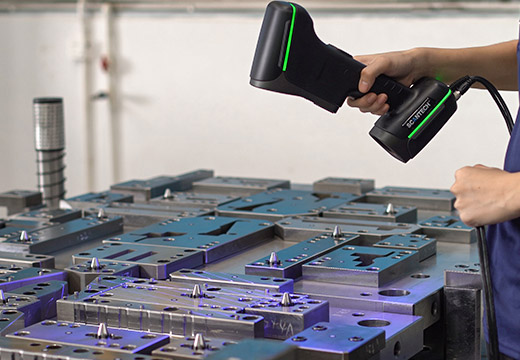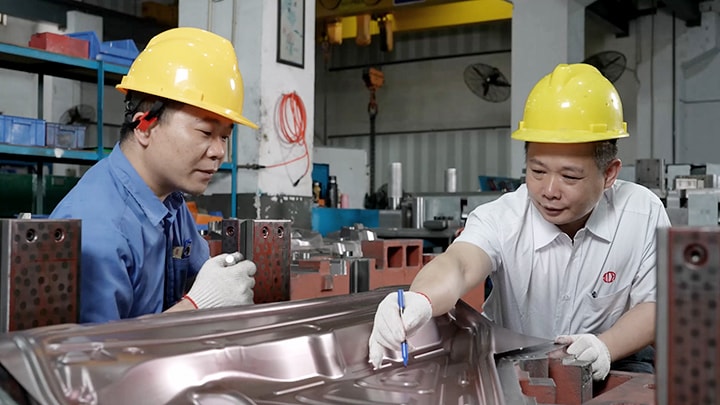In the stamping production of progressive die, the specific analysis of the bad phenomenon of stamping is carried out, and the countermeasures are taken to solve the problems fundamentally, so as to reduce the production cost and achieve smooth production. The following is a common stamping phenomenon in the production of its causes and treatment countermeasures are analyzed as follows, for mold maintenance personnel reference.
1. Punch rough edges.
(1) Reasons: A, knife edge wear; B, the gap is too large to study the knife edge after the effect is not obvious; C, knife edge collapse angle; D, the gap is unreasonable up and down offset or loose; E. dislocation up and down.
(2) Countermeasures: A. Study the knife edge; B, control the machining accuracy of male and female die or modify the design gap; C, research knife edge; D, adjust the blanking gap to confirm the template hole wear or molding parts processing accuracy and other problems; E, replace the guide or regroup the mold.
2. Scrap injury
(1) Reasons: A. Large clearance; B. improper feeding; C, stamping oil drops too fast, oil sticks; D, the mold is not demagnetized; E, punch wear, chip pressure attached to the punch; F, punch is too short, insert die length is insufficient; G, the material is hard, punching shape is simple; H. emergency measures.
(2) Countermeasures: A. Control the machining accuracy of male and female dies or modify the design gap; B, when sent to the appropriate position, trim the material belt and clean the mold in time; C, control the amount of stamping oil dripping, or replace the oil type to reduce viscosity; D mold, research and repair back magnetic (iron punching material must pay more attention to);E, research punch knife edge; F, adjust the punch blade into the length of the die; G, change material, modify the design. The punch blade enters the end face to be pushed out or cut out the inclined plane or arc (pay attention to the direction). Reduce the bonding area between the end face of the punch edge and the chip; H, reduce the sharpness of the cutting edge of the female die, reduce the amount of research on the cutting edge of the female die, increase the roughness (coating) of the surface of the straight edge of the female die, and use a vacuum cleaner to suck the waste. Decrease the impulse speed and reduce the chip jump.
3. Scrap blocking
(1) Reasons: A. The leakage hole is small; B, the leakage hole is too large, and the chips roll; C, the knife edge is worn and the burr is large; D, stamping oil drops too fast, oil sticks; E, the surface of the straight edge of the concave die is rough, and the powder chips are sintered and attached to the edge; F. soft material; G. emergency measures.
(2) Countermeasures: A. Modify the leakage hole; B, modify the leakage hole; C, blade repair knife edge; D, control the amount of oil dripping, change the oil type; E, surface treatment, polishing, processing pay attention to reduce surface roughness; Change the material, f, modify the blanking gap; G, punch cutting edge end face trim slope or arc (pay attention to direction), use a vacuum cleaner, add air blowing at the blanking hole of the backing plate.
4. Variation of blanking deviation size
(1) reasons: a,. The knife edge of the male and female die is worn, resulting in burrs (large shape and small inner hole);B, improper design size and clearance, poor processing accuracy; C, the material level punch and die insert deviation, uneven clearance; D, guide pin wear, insufficient pin diameter; E. wear of the guide member; F, feeder feeding distance, pressing and relaxation adjustment; G, improper adjustment of mold closing height; H, the material level of the stripping insert is worn, and there is no material pressure (strong pressure) function (material traction and material turning cause small punching);I, unloading insert strong pressure is too deep, punching is too large; J, stamping material mechanical performance variation (strength elongation is unstable);K, punching, punching force on the material traction, causing dimensional variation.
(2) Countermeasures: A. Study the knife edge; B, modify the design, control the processing accuracy; C, adjust its position accuracy, blanking gap; D, replace the guide pin; E, replace the guide post, guide sleeve; F, readjust the feeder; G, readjust the mold closing height; H, grinding or replacing the stripping insert, increasing the strong pressure function, adjusting the pressing material; I. reduce the depth of strong pressure; J, replace the material, control the quality of the feed; K, punch blade end surface trim slope or arc (pay attention to the direction), in order to improve the punching force condition. When permitted, the blanking part is located on the unloading insert with a guiding function.
5. Reasons for material stuck (1): A. Improper adjustment of feeder feeding distance, material pressing and relaxation; B, the delivery distance in production varies; C. feeder failure; D, material arc, width out of tolerance, large burr; E,
Abnormal die stamping caused sickle bending; F, insufficient hole diameter of the guide material, upper die pulling material; G, bending or tearing cutting position up and down stripping is not smooth; H, the stripping function of the guide plate is improperly set, and the material belt is taken; I, the material is thin and warped during feeding; J, improper mold erection, and the verticality deviation with the feeder is large.
(2) Countermeasures: A. Re-adjustment; B. readjustment; C. adjustment and maintenance; D, replace materials, control the quality of feeding; E, eliminate the material with sickle bending; F, study punch guide hole convex and concave die; G, adjust the spring force, etc.; H, modify the guide material, prevent the material belt belt; I, between the feeder and the mold to add upper and lower pressure material, add up and down extrusion switch; J. Re-erect the mold.



